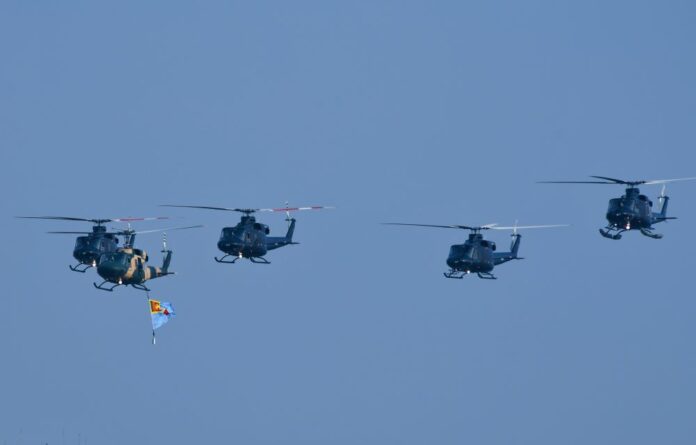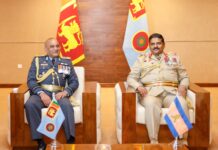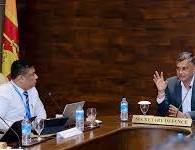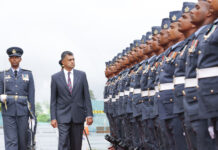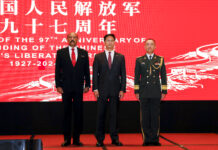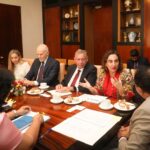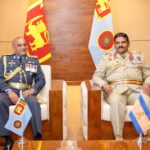As the Sri Lanka Air Force steps in to its glorious 73rd year of yeoman service to the nation,
No 4 Helicopter Squadron being one of its oldest and trusted cradle is growing steadily in stature with its gifted men and machines.
Founded in 1955 as a separate Flight of No 2 Squadron, by today No 4 Helicopter Squadron has grown in professionalism and reputation as one of the most experienced operational Squadrons of Sri Lanka Air Force. Not limiting itself to one sphere, No 4 Squadron operates its helicopters in various configurations and modes in order to fulfill its operational aims. The operational record of Squadron in the North and East insurgency is legendary, where it had taken part in almost all of the major operations and campaigns until 1994 and some of the major operations after 1994 flying countless number of combat sorties totaling more than 46000 combat flying hours.
No 4 Helicopter Squadron is fondly called “HOME OF THE HELICOPTER PILOTS” as it was the very first helicopter Squadron established by Sri Lanka Air Force. From its establishment up to 1994, it was the main institution for carrying out Basic and Advance helicopter conversions and subsequent career upgrading of helicopter pilots. It was also entrusted with the task of conveying both local and foreign VVIP/VIP dignitaries.
This prestigious Squadron had been the initial launching platform for few past commanders in the Air Force out of which the first serving Air Chief Marshal and the Marshal of the Sri Lanka Air Force. This proves that No 4 Squadron from its inception has been producing a different breed of aviators for Sri Lanka Air Force.
The history of No 4 Squadron begins with the arrival of Doves in 1955 and the acquiring of two S51 Helicopters (which was commonly known as the “Dragonfly”) by the Air Force. The Dragonfly S51 helicopter was also in the strength of No 2 Squadron, but for all intents and purposes, was a separate “FLIGHT” under the command of Flying Officer Situnayake. Both of these squadrons were based at Katunayaka with Sqn Ldr Short as the Commanding officer.
In 1968 the RCyAF purchased 03 Bell Jet Ranger helicopters to be used for VIP transportation. Thus the birth of No 4 Helicopter Flight as a separate entity under the command of
Sqn Ldr M De Zoyza took place. Later, it was renamed as No 4 Helicopter Squadron under the command of Sqn Ldr A Walter Fernando.
No 4 Squadron received the status of independent unit on 01 June 1965 and continued to provide VIP transportation, reconnaissance flights, cargo flights, Air/Sea and Jungle rescue flights, causality evacuation (CASEVAC) and other operational flights with its Bell Jet Ranger helicopters.
By the end of 1971, Air Force had developed over a period of 20 years within the limitations of national economy, to be small, but an efficient organization for transport, reconnaissance and rescue duties and also to aid the civil authorities during times of civil unrest. Further, the recently purchased Bell Jet Rangers gave a significant degree of mobility to VIPs and officials to fly to remote areas. Apart from this task, the Jet Rangers were deployed in various stations such as Colombo and Mannar to aid Sri Lanka Navy in detecting smugglers.
No 4 Squadron has played a comprehensive role of serving the VIP/VVIP air ferrying requirements as well as carrying out offensive and defensive air operations within the period from 1983 to 1993. Looking in a historical perspective, one could see that the responsibilities of No 4 Squadron were only demarcated in around 1993 when MI-17s entered service and with the forming of the No 401 Helicopter Squadron to cater the increasing demand of the offensive and defensive requirements requested by the armed forces and the Police/STF personnel.
In concise terms, it can be stated that for almost four decades, all rotary wing aircraft operations were in the sole domain of No 4 Squadron. In addition to serving the requirements of VIP/VVIP including Heads of State of other countries and other foreign dignitaries, the Squadron has participated in all military operations carried out by Sri Lanka Army and SLAF Regiment. Further, the Squadron helicopters have rendered necessary air support to Navy and Police whenever the requirements arose.
In 1994, in order to cater the growing operational requirements, No 4 Helicopter Wing was divided and a separate Squadron was formed as No 401 Squadron (later named as
No 7 Squadron). No. 401 Squadron was positioned at Sri Lanka Air Force Base Hingurakgoda, tasked primarily to fly operational missions and to conduct training for helicopter pilots in
Jet Rangers and Bell 212. No 402 Squadron was primarily tasked to conduct VVIP/VIP flights in
Bell 412s and continued to function from Sri Lanka Air Force Base Katunayake.
Humanitarian Assistance and Disaster Relief Operations were undertaken solely by
No 4 Helicopter Squadron up till 1994 and it continues to stand watch ready to take the skies whenever the requirement arises. The Squadron boasts of serving the nation and its people during such calamities despite the war and during times of peace. No 4 Helicopter Squadron has been an asset to Sri Lanka Air Force when the Squadron yet again stepped up to the plate by becoming the 1st Squadron to successfully modify one of its helicopters to fight the African locust plague, which became a looming threat to this island nation in the recent past.
The task carried out by No 4 Squadron is indeed remarkable considering its multi-faceted operations since inception. In spite of the intensive flying, the Squadron is credited with the lowest accident rate in the Sri Lanka Air Force. As can be readily discerned, the squadron has played a pivotal role in providing vital links in the backbone of the SLAF. Hence, it can be seen that the legacy of No 4 Squadron defined a major part of flying history in Sri Lanka and of the Sri Lanka Air Force as we know it today.



